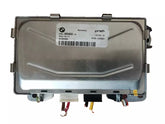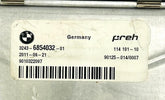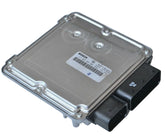TL؛DR - النقاط الرئيسية
-
وحدة التحكم في المحرك (ECU) هي الكمبيوتر الموجود على متن السيارة والذي يدير الوقود والتوقيت والانبعاثات للمحركات الحديثة.
-
بحلول عام 2024، ستستخدم حوالي 98% من المركبات الجديدة في الولايات المتحدة وحدات التحكم الإلكترونية، لذا فإن صحة وحدة التحكم الإلكترونية مهمة بالنسبة لمعظم السائقين (المصدر: Automotive News).
-
تعمل وحدات التحكم الإلكترونية على معالجة ملايين الحسابات في الثانية الواحدة من أكثر من 30 مستشعرًا وتؤثر بشكل مباشر على الطاقة واقتصاد الوقود والانبعاثات.
-
تنتج الأعطال الشائعة عن أعطال المستشعرات، ومشكلات الأسلاك، والأخطاء البرمجية؛ ويعتمد الإصلاح أو الاستبدال على التشخيص وقيمة السيارة.
-
تتضمن خيارات الاستبدال وحدات جديدة، وإعادة تصنيعها، ومستعملة؛ كما أن البرمجة، ومطابقة رقم تعريف المركبة (VIN)، وفحوصات منع الحركة ضرورية.
تعريف بجملة واحدة
وحدة التحكم في المحرك (ECU) عبارة عن كمبيوتر رقمي مدمج يقرأ مدخلات المستشعر ويصدر الأوامر لمشغلات المحرك لتحسين الأداء والكفاءة والانبعاثات.
1) ما هي وحدة التحكم في المحرك ولماذا هي ضرورية؟
وحدة التحكم الإلكترونية (ECU) هي العقل الإلكتروني للمحرك، وهي المسؤولة عن ضمان تشغيله بشكل صحيح. تجمع هذه الوحدة المدخلات، وتُشغّل نظام التحكم المنطقي، وتُرسل الأوامر إلى الحاقنات والملفات والصمامات. ولأن حوالي 98% من السيارات الأمريكية الجديدة تستخدم وحدات تحكم إلكترونية ، فإن أي عطل في هذه الوحدة يؤثر على سهولة القيادة، واستهلاك الوقود، وملاءمة الانبعاثات. ينبغي على مالكي السيارات الانتباه، لأن عطل وحدة التحكم الإلكترونية قد يُضيء ضوء فحص المحرك، ويؤدي إلى فشل اختبارات الانبعاثات أو سلوك تشغيل غير آمن.
٢) كيف تعمل وحدة التحكم الإلكترونية؟ المستشعرات والبيانات والمحركات
تقرأ وحدة التحكم الإلكترونية (ECU) المستشعرات، وتُجري الحسابات، وتتحكم في المحركات آنيًا. تُجري عينات من عشرات المُدخلات، وتُطبّق الخرائط والخوارزميات، وتُعدّل الوقود، والتوقيت، والتحكم في وضع الخمول. تُجري الوحدات الحديثة ملايين الحسابات في الثانية، وتستقبل عادةً بيانات من أكثر من 30 مستشعرًا. يبدو هذا التسلسل كالتالي: المستشعرات ← وحدة التحكم الإلكترونية ← المحركات (الحاقنات، الإشعال، صمام الخمول).
مدخلات المستشعر المشتركة التي يستخدمها وحدة التحكم الإلكترونية
-
تدفق كتلة الهواء (MAF) / الضغط المطلق للمجمع (MAP)
-
مستشعرات الأكسجين (O2) / لامدا
-
درجة حرارة سائل التبريد (ECT)
-
درجة حرارة الهواء الداخل (IAT)
-
موضع العمود المرفقي وعمود الكامات
-
مستشعر موضع الخانق (TPS)
-
ضغط سكة الوقود / تيار الحاقن
-
مستشعر الطرق
-
إشارات ABS/VSS (في وحدات التحكم في مجموعة نقل الحركة المتكاملة)
-
بيانات جهد البطارية والتشغيل
نصيحة: تساعد الموصلات الشفافة والخالية من التآكل على الحصول على قراءات دقيقة للمستشعر وأداء مستقر لوحدة التحكم الإلكترونية.
3) ECU مقابل ECM مقابل PCM: ما الفرق في الممارسة العملية؟
تشير جميع هذه الاختصارات إلى أجهزة التحكم في المحرك، مع اختلافات طفيفة في نطاقها. غالبًا ما تعني وحدة التحكم الإلكترونية (ECU) وحدةً تُركز على وظائف المحرك. أما وحدة التحكم في المحرك (ECM) فهي مرادفة لها. أما وحدة التحكم في مجموعة نقل الحركة (PCM) فتجمع بين التحكم في المحرك وناقل الحركة. يستخدم الفنيون والعلامات التجارية المصطلحات بالتبادل، لذا تأكد من فحص أسلاك السيارة وتشخيصاتها بدلًا من الاعتماد على الملصق.
4) كيف يؤثر وحدة التحكم الإلكترونية على كفاءة الوقود والانبعاثات؟
تُحسّن وحدة التحكم الإلكترونية (ECU) نسبة الهواء إلى الوقود وتوقيت الاشتعال لتحسين الاقتصاد في استهلاك الوقود وتقليل الملوثات. وتستخدم تغذية راجعة من مستشعر الأكسجين لضبط توصيل الوقود والحفاظ على توازنه. يؤثر التحكم الدقيق في وحدة التحكم الإلكترونية بشكل مباشر على أنظمة الانبعاثات ، مثل المحولات الحفازة ونظام إعادة تدوير غاز العادم (EGR)، مما يؤثر على الامتثال للوائح في عمليات التفتيش.
5) أعراض مشكلة وحدة التحكم الإلكترونية التي لا يجب تجاهلها
تظهر مشاكل وحدة التحكم الإلكترونية (ECU) على شكل أعطال في قابلية القيادة وأضواء تحذيرية. تشمل الأعراض الشائعة: ضوء فحص المحرك، ضعف التسارع، التوقف المفاجئ، تباطؤ غير منتظم، انخفاض استهلاك الوقود، توقف متقطع عن التشغيل، وتغيير حاد في التروس عند إدارة وحدة التحكم الإلكترونية لناقل الحركة. غالبًا ما تشير رموز الأعطال التشخيصية (DTCs) إلى أعطال في المستشعرات أو الاتصالات، وليس وحدة التحكم الإلكترونية نفسها، لذا يلزم إجراء فحص دقيق.
6) تشخيص مشاكل وحدة التحكم الإلكترونية واستكشاف الأخطاء وإصلاحها (خطوة بخطوة)
ابدأ بقراءة رموز OBD-II واعمل على فحص الأجهزة. الخطوات: استرجاع الرموز، فحص المستشعرات وأسلاك التوصيل، التحقق من الطاقة والتأريض، اختبار سلامة ناقل البيانات، التحقق من إصدار البرنامج ونشرات الخدمة الفنية، التفكير في إعادة تحميل الملف، ثم اتخاذ قرار الإصلاح أو الاستبدال. يُجنّب إجراء التشخيص المنظم عمليات تبديل وحدة التحكم الإلكترونية غير الضرورية. إذا أشارت الاختبارات إلى عطل في الأسلاك أو المستشعر، فأصلحه أولاً قبل استبدال الوحدة.
7) الإصلاح مقابل الاستبدال: ما الذي يجب أن نعرفه في عام 2025
اتخذ قرارك بناءً على التكلفة والتوافر والتوافق. وحدات التحكم الإلكترونية الجديدة من الشركة المصنعة الأصلية (OEM) توفر راحة البال، لكنها أغلى ثمنًا. الوحدات المُعاد تصنيعها توفر المال، لكنها يجب أن تطابق أرقام القطع والمعايرة. وحدات التحكم الإلكترونية المستعملة هي الأقل تكلفة، لكنها قد تُسبب مخاطر التوافق وعدم توافق البرامج. قد تُجبر متطلبات البرمجة بعض الطرازات على زيارة الوكيل.
8) الترقيات والضبط: هل يمكن ترقية وحدة التحكم الإلكترونية للحصول على أداء أفضل؟
نعم، يمكن إعادة برمجة وحدات التحكم الإلكترونية أو استبدالها بوحدات بديلة لتحسين الأداء. يأتي هذا من تعديل خرائط الوقود والتوقيت. انتبه لقوانين الانبعاثات وتأثيرات الضمان. استخدم موالفات موثوقة، وحافظ على ضوابط الانبعاثات عند الحاجة.
9) حالات الاستخدام في العالم الحقيقي: وحدة التحكم الإلكترونية في العمل
توضح الأمثلة قرارات وحدة التحكم الإلكترونية (ECU) في القيادة اليومية. أثناء التسارع الشديد، تُخصّب وحدة التحكم الإلكترونية الوقود. يُفعّل كشف الطرق إبطاء التوقيت لحماية المحرك. تُصحّح تغذية مستشعر الأكسجين حالة نقص الوقود أو وفرته، وقد تُصدر رمز تشخيصي (DTC). توضح هذه الأمثلة كيف تُؤدي بيانات المستشعر إلى إجراءات تصحيحية فورية.
10) التكلفة وخيارات الاستبدال في الولايات المتحدة (صورة 2025)
تختلف الأسعار بشكل كبير حسب الماركة والطراز. غالبًا ما تتراوح أسعار وحدات التحكم الإلكترونية الجديدة من مُصنّعي المعدات الأصلية (OEM) بين مئات الدولارات وأكثر من ألف دولار. تقع الوحدات المُعاد تصنيعها في الفئة المتوسطة، بينما تُعدّ الوحدات المستعملة الأرخص. تُضاف تكاليف العمالة والبرمجة إلى إجمالي تكلفة التركيب. للشراء، استعن ببائعين موثوقين وتحقق من أرقام القطع وتوافق رقم تعريف المركبة (VIN) - ومن الأمثلة الجيدة على ذلك مجموعة وحدات التحكم الإلكترونية من AutomAn Spare Parts (اطلع على قوائم وحدات التحكم الإلكترونية الخاصة بهم).
11) كيفية شراء أو استبدال وحدة التحكم الإلكترونية: دليل المشتري
تحقق من دقة أرقام القطع، وتوافق رقم تعريف المركبة (VIN)، ومتطلبات مانع الحركة. اسأل عما إذا كانت الوحدة مُختبرة، وما إذا كانت البرمجة أو استنساخ رقم تعريف المركبة (VIN) مطلوبين. غالبًا ما تتضمن الوحدات المُعاد تصنيعها ضمانات. للاطلاع على تنوع الكتالوج وفحص المخزون، راجع كتالوج AutomAn الذي يضم آلاف وحدات التحكم الإلكترونية وخيارات الشحن.
12) الصيانة والعناية لإطالة عمر وحدة التحكم الإلكترونية
حافظ على نظافة التوصيلات الكهربائية واستخدم بطارية سليمة. استبدل الأسلاك المتآكلة وتجنب عمليات التصليح المنزلية التي تتجاهل ميزات السلامة. عند توفر تحديثات البرامج من قِبل الشركات المصنعة، قم بتطبيقها في متجر موثوق للحفاظ على استقرار الجهاز.
13) الاعتبارات المتعلقة بالسلامة والقانون والضمان
قد يؤثر سوء عمل وحدة التحكم الإلكترونية على أنظمة السلامة وامتثالها للانبعاثات. قد يؤدي الضبط غير المصرح به إلى إبطال الضمانات وإفشال عمليات التفتيش. وثّق دائمًا تغييرات البرامج وتأكد من الامتثال القانوني لقواعد الانبعاثات المحلية.
14) الأسئلة الشائعة
ما هي وحدة التحكم الإلكترونية في السيارة؟
وحدة التحكم الإلكترونية هي وحدة التحكم الإلكترونية في السيارة التي تدير وظائف المحرك عن طريق قراءة أجهزة الاستشعار والتحكم في المحركات.
كيف تعمل وحدة التحكم الإلكترونية على تحسين كفاءة استهلاك الوقود؟
يقوم بضبط الوقود والتوقيت بشكل مستمر باستخدام ردود فعل المستشعر للحفاظ على الاحتراق الأمثل والاقتصاد.
هل يمكن إصلاح وحدة التحكم الإلكترونية، أم يجب استبدالها؟
يمكن إصلاح بعض وحدات التحكم الإلكترونية على مستوى المكونات، ولكن العديد من الطرق التشخيصية الأولى تستبدل الوحدة فقط بعد استبعاد أجهزة الاستشعار والأسلاك.
كم تكلفة استبدال وحدة التحكم الإلكترونية؟
تتراوح التكاليف من بضع مئات من الدولارات لوحدة أعيد تصنيعها إلى أكثر من 1000 دولار لأجزاء OEM الجديدة، بالإضافة إلى البرمجة والعمالة.
ما هو الفرق بين ECU وECM وPCM؟
إنها وحدات تحكم متشابهة؛ حيث تتضمن وحدة التحكم في علبة التروس PCM غالبًا التحكم في ناقل الحركة، بينما تركز وحدة التحكم الإلكترونية ECU/ECM عادةً على إدارة المحرك.
هل تتطلب وحدات التحكم الإلكترونية الحديثة برمجة الوكيل؟
يقوم البعض بذلك، وخاصةً عندما تكون هناك حاجة إلى استنساخ جهاز منع الحركة أو رقم تعريف المركبة (VIN)، على الرغم من أن العديد من المتاجر المستقلة يمكنها برمجة الوحدات أيضًا.
كيف يمكنني معرفة إذا كانت وحدة التحكم الإلكترونية الخاصة بي قد فشلت؟
ابحث عن رموز التشخيص التشخيصية المستمرة، وسلوك المحرك غير المنتظم، والاختبارات التي تُظهر قراءات مستقرة للمستشعر عندما يكون من المعروف أن الأسلاك والمستشعرات جيدة.
هل يمكن لترقيات وحدة التحكم الإلكترونية إلغاء الضمان الخاص بي؟
غالبًا ما يؤدي تغيير برمجة وحدة التحكم الإلكترونية إلى إبطال الضمان وقد يؤثر على الامتثال للانبعاثات.
15) مثال من الحياة الواقعية (مختصر)
تعطلت سيارة سيدان موديل ٢٠١٦ وعانت من أعطال في ضبط الوقود. استبدل الفنيون حساس الأكسجين المعطل، وأعادوا ضبط معايرة وحدة التحكم الإلكترونية، واستعادوا كفاءة استهلاك الوقود وسهولة القيادة.
ملخص سريع
تتحكم وحدة التحكم في المحرك في سلوك المحرك، وانبعاثاته، وكفاءته من خلال قرارات سريعة تعتمد على المستشعرات. اعتبارًا من أغسطس 2025 ، تظل وحدات التحكم الإلكترونية (ECUs) أساسية في قرارات أداء السيارة وإصلاحها. عند مواجهة أي أعراض متعلقة بوحدة التحكم الإلكترونية، ابدأ بالتشخيص، وافحص المستشعرات والأسلاك، وتأكد من متطلبات البرمجة قبل شراء بديل. للحصول على قطع الغيار وخيارات المخزون، راجع كتالوجات مثل مجموعة وحدات التحكم الإلكترونية من AutomAn واستشر مزودي الخدمة الموثوقين.
المصادر والقراءات الإضافية
-
ملخص أخبار السيارات حول اعتماد إلكترونيات المركبات: https://www.autonews.com
-
إرشادات جمعية خدمة السيارات بشأن اتجاهات التشخيص: https://www.asashop.org
-
قوائم وحدات التحكم الإلكترونية لقطع غيار Automan: https://automanspareparts.com/collections/ecu-engine-control-units







